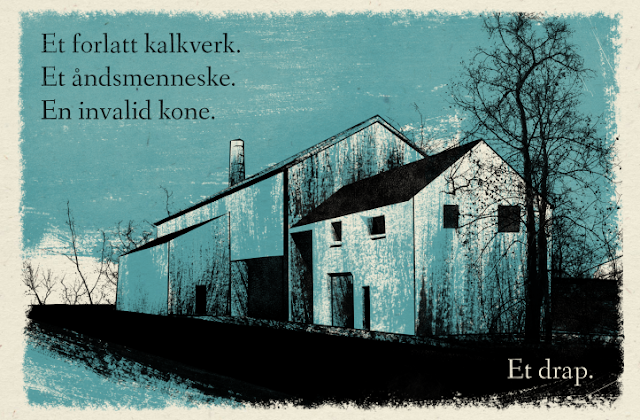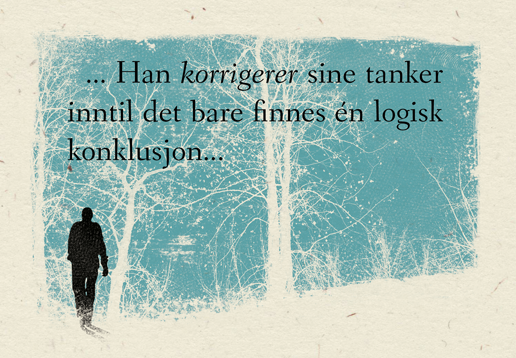Espen Terjesen's beautifully drawn essay on Bernhard's writing
I'm very excited to share a beautiful and concise 'comic essay' on the work of Austrian writer Thomas Bernhard. The essay was written, drawn and designed by Espen Terjesen, an illustrator, cartoonist, pixel artist, teacher/lecturer and writer working in Bergen, Norway. In addition to the original essay, Terjesen has also been kind enough to provide A Piece of Monologue with an English translation.
Terjesen's work not only presents themes from Bernhard's writing with striking, icy accompaniments, but offers a playful approach to the traditional academic essay. By combining elements of literary criticism with the graphic novel, Terjesen's reading of Bernhard becomes, in itself, a creative act. What we are left with is something both thought-provoking and accessible.
To see the strip in its original format, please find links to Terjesen's essay at the bottom of this post. In its complete form, the essay includes a number of footnotes and recommended reading. You can click any of the images to enlarge them. Enjoy!
The Essay
Page 1
Title: Refutations / The prose of Thomas Bernhard / By Espen Terjesen
Panel 1: An abandoned lime works. / An intellectual. / A disabled woman. / A murder.
Panel 2: A visitor tries to clear up the circumstances surrounding the murder. He collects gossip and rumours in the local tavern, Laska...
Panel 3: The Lime Works (1975) is in many ways a typical Bernhard text...
Panel 4: The narrator and the text's fictitious writer, a nameless insurance salesman, meticulously repeats the reports he gets from his informants, Fro and Wieser...
Panel 5: ...but the information is usually second- to fifth-hand...
Panel 6: The Lime Works seems to linger on in a state of probability and uncertainty. The text is abound with narrators and readers...
Panel 7: ...who construct and reconstruct subjective and incompatible worlds...
Panel 8: Where modernist prose portrays different "psychologies"...
Panel 9: ...and how these face (the same) world...
Page 2
Panel 1: ... Bernhard's prose seems to portray a narrative form of "the whispering game". / ...Author1 creates Text1 (and World1). Reader1 reconstructs World1 - and becomes, therefore, the creator of World2 etc.
Panel 2: [figure demonstrating this process]
Panel 3: The nameless, unreliable insurance salesman is the last in a long line of narrators - and our only entry into the chinese boxes that is The Lime Works... Still, he does not make any attempts in sorting or verifying the information (gossip?) he receives...
Panel 4: With that, the text raises ontological questions: what is literary truth? ...
Panel 5: ... what is the nature of fiction?; what constitutes a world? ...
Panel 6: ... The hypothesis works as a poetic trope in the works of authors like Marcel Proust, Thomas Mann, and André Gide. Best known is perhaps Proust's expansive hypotheses in In Search of Lost Time ...
Panel 7: ... Bernhard's "answer" is contradictions and refutations ... / There's no longer any "reality" that can verify the hypotheses...
Panel 8: ... Reality is nothing but a composition of ...
Panel 9: ... interpretations and fictions...
Page 3
Panel 1: ... Hypothetical thinking's inherent defects, weaknesses and inaccuracies become an obsession for Roithamer - an architect based on Ludwig Wittgenstein - in Bernhard's Corrections (1975)...
Panel 2: ... He corrects his thoughts until there's only one logical conclusion left...
Panel 3: ... to negate his own existence...
Panel 4: ... Is it at all possible to write truthfully? ... / ... The Lime Works and Correction problematize literary truth-searching in, at least, two ways: 1) by using exceedingly indirect and complicated narrative techniques - which makes first-hand information an impossibility...
Panel 5: ... 2) by portraying isolation, resignation and defeat - how persons positively obsessed with truth ...
Panel 6: ... and perfection...
Panel 7: ... go...
Panel 8: ... under...
Esper Terjesen: About the Strip
While working at the University of Bergen, I started thinking about combining my interest in literature and drawing. It was only a few years later, though, that I sat down to draw a graphic essay on Thomas Bernhard, my favourite author. My aim was, first and foremost, to develop a visual language that would suit future essays on academic topics. This essay was, therefore, improvised on the spot. I didn't plan or write anything in advance. I just followed my own train of thoughts while drawing. Needless to say, the result is somewhat unfocused, but I'm still happy with the overall mood and feel of the essay.When it comes to the contents itself: To me, a lot of Thomas Bernhard Criticism seems to be founded on realistic-mimetic and psychological theories (often of a biographic-affirmative nature) and the idea that Bernhard is a modernist (along the lines of authors like Thomas Mann, James Joyce and Marcel Proust). I would argue that it makes more sense to associate Bernhard with postmodern literature and writers. Modernist literature seems, to me, at least, to raise epistemological questions (what can we know?). We are presented with different "psychologies", and how these view and/or meet the (same) world. Postmodern literature, on the other hand, raises ontological questions (what constitutes a world?). It deals with literary truth (is it at all possible?), the nature of fiction, and how (fictional) worlds relate.
One of the most important literary tropes in Bernhard's prose, is "refutation". Where Proust writes extensive hypotheses, Bernhard's prose seems to consist of nothing but refutations. This is perhaps best viewed in Bernhard's Das Kalkwerk and Korrektur, which I discuss in the essay. The former having up to five levels of narration, muddling up the narrative. The latter describing how an architect "corrects" and adjusts his philosophy until the only logical conclusion is to negate his own soul.
Website
You can see the complete essay, along with photographs of the project's development, on Esper Terjesen's website.Completed essay:
- Thomas Bernhard, Comic Essay, page 1.
- Thomas Bernhard, Comic Essay, page 2.
- Thomas Bernhard, Comic Essay, page 3.
Also at A Piece of Monologue:






























